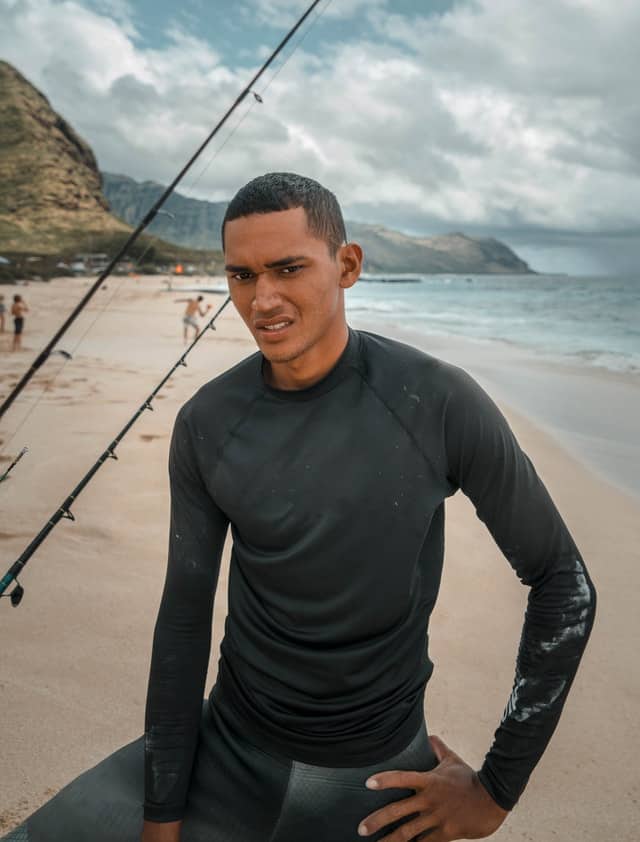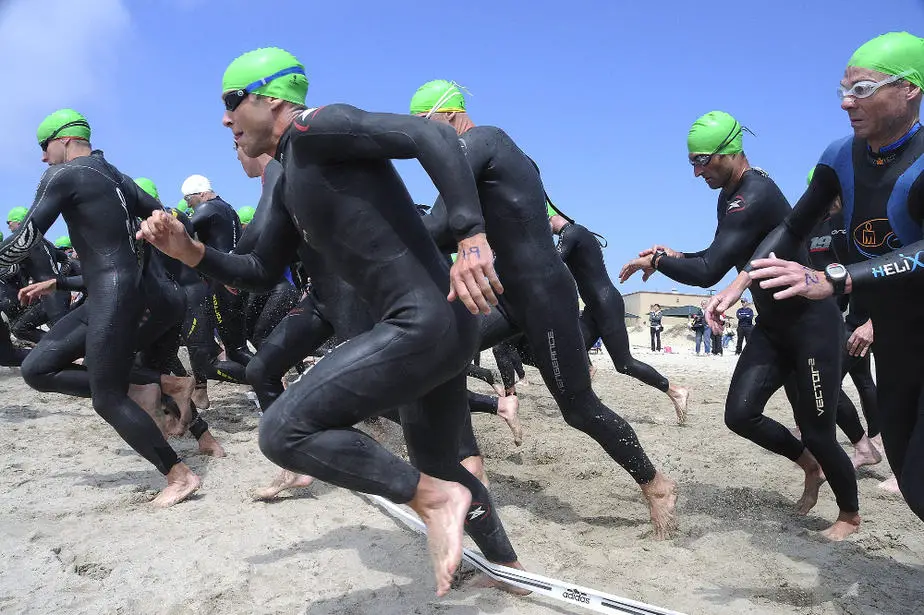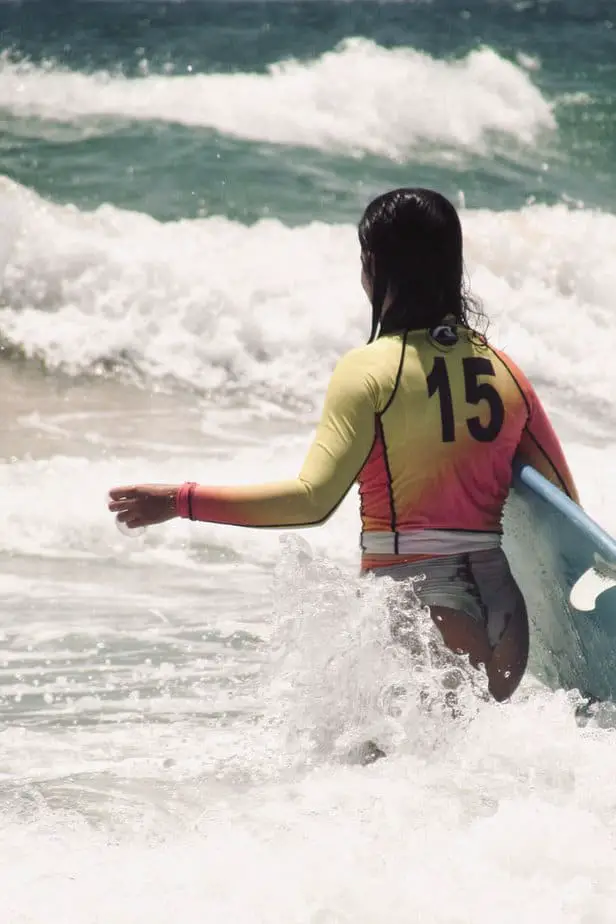Since humans are basically hairless apes, we have a dependence on clothing to keep ourselves warm. That said, normal clothing like a cotton shirt and shorts become a safety risk when we are in the water, so we are forced to take most of it off and wear a swimsuit instead. Most swimsuits expose large swaths of bare skin which is a problem for some people.
In the summer, the near-nakedness of wearing a swimsuit feels amazing; if you’re fit, you get to show off your body, and even if you aren’t, it feels good to take off all that hot clothing and feel the wind on your skin. As liberating as this is, it also comes with its fair share of risks.
Since most swimsuits are very revealing, you no longer have the protection that wearing clothing provides. You become more susceptible to the sun’s UV rays, to superficial damage like cuts and scratches from sharp rocks or other debris, as well as stings from jellyfish.
The most prominent difference is how cold one gets without clothing on. Most swimsuits don’t do a good job of keeping you warm against the heat draining effects of water. This has caused many swimmers to look for long sleeved swimsuits because they think that it can keep them warm.
While a long sleeve swimsuit does technically provide more protection than a more revealing swimsuit, like its sleeveless counterpart it does not do a good job of keeping you warm either. That is not the purpose of swimsuits or rash guards, so if staying warm was your number one priority, you’ll have to find another solution. What is designed to keep you warm is a wetsuit, but that comes with its own list of pros and cons, some of which you may not like.
If you keep reading on, we will discuss what benefits long sleeve swimsuits (a.k.a. Rash guards) actually provide you (and what they don’t), as well as which swimwear can keep you warm in the water and why you should wear that instead.
Why long sleeve swim shirts don’t keep you warm
On land, regular clothing does a decent job of insulating your body heat, thereby keeping you warm. Most clothes can trap heat efficiently, and depending on the material, can even block the wind. The end result is that you can stay warm with the right clothes even if it’s chilly out.
If you try to apply the same logic to a swimsuit, unfortunately that is where things fall apart. First off, water can easily go where it’s not supposed to; even the tiniest opening will allow water to enter, and even skin tight clothing cannot keep water out. On top of that, water is 25 times more effective at conducting heat away from your body than air.
Since swimsuits aren’t waterproof due to the large openings for your neck, arms, and legs to fit through, you can bet that the water is going to enter, come into contact with every square inch of your skin, and conduct body heat away from you rapidly.
Furthermore, most swim shirts and rash guards are loose and stretchy. A loose rash guard will not be in close enough contact with your skin to limit the amount of water entering. We also have to consider the materials that swimsuits are made of, nylon and lycra, which are designed primarily to be stretchy and quick-drying, not insulating.
Depending on how thick your rash guard is, it may provide some warmth in the water, but don’t count on it making a significant difference. Basically, don’t count on any kind of swim shirt to keep you warm.
What long-sleeve swimsuits actually do for you

Rather than insulating your body heat, this is what swim shirts and rash guards actually do for you.
UV protection
Most swimsuits have a ultraviolet protection factor (UPF) which is a numbered rating of how many UV rays it can block. If a swimsuit has a UPF of 50, that means that out of 50 UV rays, it will only let 1 ray slip through and reach your skin, therefore it has a 98% UV ray block rate. It’s very likely that your swimsuit is UPF 50, or at least UPF 30 (97% block rate).
Knowing this, swimsuits that expose lots of skin do a terrible job of protecting your skin from UV rays, which can cause accelerated aging, skin cancer, and painful sunburns. Conversely, swimsuits that cover a large portion of your skin are excellent for limiting the amount of UV rays reaching your skin to manageable levels.
With a rash guard, you can save so much time and money by not needing to use a bunch of sunscreen since areas covered by the swimsuit are already protected. You also don’t have to worry about re-applying sunscreen to the covered areas every hour or so. Another great benefit is that hard to reach places like your back don’t need sunscreen since it will be covered up, which is great for solo swimmers.
Protection from cuts, scratches, and stings
A rash guard is like a second layer of skin that can provide some amount of superficial protection from sharp rocks, sticks, coarse sand, coral, and jellyfish stings. If you have a big enough accident, chances are your rash guard is going to get torn and you’ll still draw blood. But for minor incidents, you might be able to get by without a scratch. So while it’s not much, it’s better than nothing.
Increases visibility
Thanks to the cool designs you can get on a long sleeve swimsuit, you can simultaneously be fashionable and safer by improving your visibility in the water. If you end up needing to be rescued, it will be easier for rescuers to spot you if your swim shirt is brightly colored or has a unique design.
Covers you up
Not everyone is comfortable with how much skin most swimsuits show. Thus, being adequately covered up can be a huge confidence booster for some swimmers. It is also great for looking more modest, especially if there are families with young children around, or if you’re hanging out with family members and don’t want to give them the wrong idea.
Why you should wear a wetsuit for warmth

While long sleeve swimsuits provide many great benefits, the topic of this article is whether it can keep you warm, which it doesn’t do a good job at.
Rather than ending the article on such a low note, we want to instead inform you of an alternative solution which can keep you warm in the water. That solution is the wetsuit, which anybody with scuba diving experience should be intimately familiar with.
There are various types of wetsuits, but you should specifically get a triathlon wetsuit if you plan on doing any kind of swimming. For maximum warmth, and at the expense of mobility, scuba diving wetsuits are much thicker and are designed to allow you to stay in the water for as long as possible.
Wetsuits are able to specifically keep you warm because they are made with neoprene. Neoprene does not let water penetrate through it (though water can still enter the suit from other openings).
It is also quite thick and has air bubbles trapped inside it. These air bubbles are great for insulation, as they prevent most of the heat your body generates from escaping through the suit itself, which is the secret to how wetsuits keep you warm.
When you wear a wetsuit, water will still enter the wetsuit, yet you will still stay warm. This is hard for people to wrap their head around, but it’s true. That is because a wetsuit is so effective at insulating your body heat, any water that enters gets warmed up by the trapped heat.
Since wetsuits are also tight fitting, most of that water that enters is trapped around your body and heated up, effectively creating a warm layer of water around your body that allows you to stay warm in the water despite how effective water is at conducting heat away from your body.
On top of that, wetsuits provide all of the same benefits that a rash guard provides, like UV protection, even greater superficial protection due to its thickness, and you can also get wetsuits that are different colors instead of the usual black.
It even has an added benefit of being very buoyant thanks to all of the air bubbles trapped within the neoprene. This is great for conserving energy because staying afloat becomes a trivial issue. However, if you plan on diving, it’s going to be much harder to overcome your newfound buoyancy.
The downsides of wetsuits are that they are expensive, they can restrict your mobility, they can make you feel too warm, especially out of the water, and they can be hard to put on without help.
So while long sleeve swimsuits cannot keep you warm, a very similar kind of swimwear that does keep you warm exists, and it is the wetsuit. Consider wearing a triathlon wetsuit the next time you go swimming outdoors.

